May 8, 2025 Artificial Intelligence
AI in Transportation: Redefining Use Cases, Its Benefits, and Future Trends
May 8, 2025 Artificial Intelligence
Table of Contents
May 8, 2025 Artificial Intelligence
So, how AI in transportation industry setting up a new trend? Well, have you ever thought of witnessing a car driving without a driver, traffic lights adjusting automatically in real-time, and GPS rerouting depending upon the traffic conditions?
Well, it has become a new reality, and all thanks to the entry of AI in transportation industry.
Back in 2016, the self-driving truck made history by delivering a load of beer across 120 miles in Colorado, with no human driver behind the wheel.
What once felt like science fiction is now becoming reality. From smart traffic systems in busy cities to delivery trucks that predict their maintenance well in advance, Artificial Intelligence is making big changes in how we move.
AI is not just improving transportation, it’s transforming it. With growing urban populations, increasing ecommerce demands, and rising fuel costs, the transportation industry is in demand for faster, efficient, and smarter options.
This is where AI enters as the game changer. Ensuring smarter routing, autonomous vehicles, real-time analytics, and predictive decision-making across the entire transportation ecosystem.
According to the reports, the global AI adoption in the transportation market is expected to be worth around $21.4 billion by 2033 from $ 3.6 billion back in 2023.
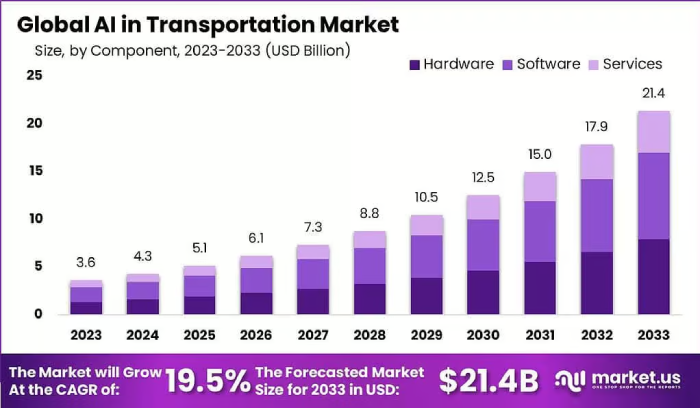
This growth highlights the increasing adoption of AI technologies across the transportation industry. The adoption of AI development services is not limited to the development of self-driving cars, but also includes predictive analytics, machine learning, and computer vision technologies that empower businesses to make data-driven decisions.
If you are in the transportation industry, looking to expand your business, then leveraging Artificial Intelligence will be a worthy decision. Let’s explore the manifold benefits of adopting AI technology in the transportation industry and its use cases.
Artificial Intelligence in transportation refers to the integration of advanced technologies like machine learning, data analytics, and smart algorithms to transform the way people move.
These AI systems can process a massive amount of data from sensors, cameras, GPS, and traffic systems to make real-time decisions, predict maintenance issues, and even automate tasks.
From self-driving vehicles to smart traffic lights, AI in transportation is making a big way to provide cost-efficient transportation options.
So, how is AI used in transportation? The transportation industry is one of the largest and most complex sectors, which is controlled and managed by various stakeholders and a vast amount of data. This is where AI in transportation enters and transforms the industry in various ways.
Before you hire a mobile app developer, you need to understand that transportation AI helps in optimizing route planning, vehicle maintenance and tracking, supply chain management, and traffic management.
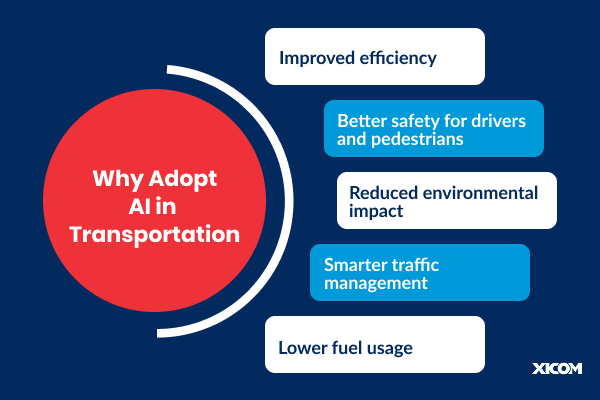
Let’s take a precise look at the major role of Generative AI technology in transportation and how it is automating processes, optimizing operations, and providing data-driven insights:
Driverless cars make the most happening and grabbing headlines, when it’s about discussing the role of AI in transportation. These self-driving cars rely on AI-powered systems that combine data from cameras, radar, and GPS to interpret their surroundings.
Moreover, with this data, it becomes easier to navigate roads and make split-second decisions all without human intervention. This technology is shaping the future of a safer, more efficient, and driverless mobility experience.
AI is quickly taking out the chaos from the traffic by empowering the strength of adjusting traffic lights in real-time and analyzing the real-time traffic patterns for precise route planning.
Whether you are managing food deliveries in real time, taxi hailing services, or managing ecommerce inventory, AI can help you plan deliveries and rides accurately.
AI helps cities optimize traffic signals, manage flow, and reduce travel bottlenecks. Ultimately, the result is shorter commutes, smoother traffic, and a big step forward in urban mobility.
AI is making public transportation more responsive and rider-friendly. By simply forecasting the ride demand and analyzing customer behavior, AI helps authorities optimize routes, schedules, and fleet deployment.
It benefits the passenger too with the real-time updates, accurate arrival times, and smarter route planning for better daily travel experiences.
One of the best examples of transportation technology in action is efficient fleet management powered by AI. Managing the large fleets across cities or regions is no small task, but AI makes it smarter and easier. It identifies the most fuel-efficient routes, monitors like traffic and weather conditions, and accordingly checks for vehicle health.
With predictive maintenance, AI can detect issues before they lead to breakdowns. AI in transformation has ultimately reduced the downtime and saved both time and operational costs. This is a prime example of how modern transportation technologies are streamlining logistics and boosting productivity.
So, how about the future of AI in transportation? It’s always concerned with safety and security, standing at the forefront. AI is revolutionizing road safety standards by simply using advanced driver-assistance systems, real-time object detection, and monitoring driver fatigue levels.
These systems drastically reduce the chances of accidents caused by human error. Whether it’s an autonomous vehicle or traditional ones, AI brings a new level of precision and intelligence that safeguards lives.
Undoubtedly, AI continues to evolve with each passing year. The usage of AI in the transportation industry enables systems to work better and in a responsive way. If you are still hesitating to hire an AI development company to adapt this change into your transportation business, then you need to check out these real-life use cases of AI.
AI transportation systems are at the heart of autonomous vehicle development. According to Statista, there were 31 million cars available with at least some level of automation in operations. It is expected that their number will surpass 62 billion in 2026.
Wondering why and how?
Well, the mechanism of self-driving cars is working with the real-time data that they gathered from sensors, cameras, and GPS. That data is extracted from the AI technology that they used, which helps gather data from sensors, cameras, and GPS to interpret the surroundings and allows smart vehicles to make intelligent decisions.
Now, before you take all the things like we say, let’s take a deeper insight:
Using AI in public transportation is making it more organized and enabling it to offer smarter and personalized travel experiences. This happens as integrated AI algorithms in public transportation help analyze the patterns in commuter behavior and flow of traffic.
Apart, here’s what it offers while using the AI in public transportation:
The demand for smart parking management is increasing due to the rising concern of traffic congestion, wastage of fuel, and increasing concern of environmental pollution.
This is where smart parking systems, leveraging technologies like AI, IoT, and real-time data, offer the best solution to drivers in navigating the parking spaces, reducing search stress, and optimizing parking space utilization.
Reports say that the global parking systems market was valued at $6.49 billion in 2022 and is expected to grow at 22.1% from 2023 to 2030.
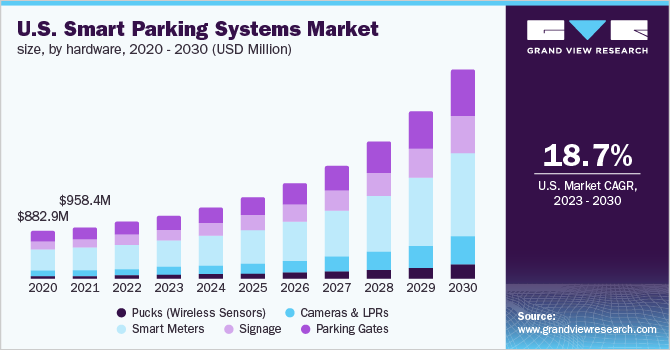
Now the question is, how does AI work in smart parking management systems? Here’s how AI is playing a key role in modernizing how we manage urban parking and solving a major problem for drivers and cities.
Redefine the travel experience for the users by simply implementing AI-powered chatbots that not just automate the customer queries but also provide intelligent ways of guiding users to better prepare for personalized travel. But what exactly can AI-powered chatbots do for you?
Let’s get into it…
One of the most exciting advancements in the transportation AI space is the deployment of autonomous drones for logistics and delivery monitoring.
But practically, how far will it be successful?
AI has made the automotive industry work more intelligently by automating such repetitive tasks. This is why various huge enterprises and even startups are increasingly using gen AI possibilities in transportation. If you’re still hesitating to hire software developers, then you need to check out these real-life examples of AI in transportation…
Tesla’s Autopilot is a perfect example of autonomous cars that use AI systems for navigating roads with minimal human input. It relies on sensors, cameras, and radar for detecting conditions and travel obstacles.
In addition to that, the system can change lanes, adjust speed, and even prevent accidents by taking control during emergencies and sensing objects from 20 meters.
To outperform in the future, Tesla continuously updates Autopilot through over-the-air improvements. This allows the system to evolve and become safer over time. Autopilot is one of the most well-known examples of AI’s role in moving towards fully autonomous vehicles.
Amazon is the first to develop AI-powered drones to improve package delivery. These drones use AI algorithms for navigation, identifying obstacles, and selecting the best routes for delivery. Moreover, the in-built AI system lets them adjust in real-time to changing weather conditions, ensuring that packages are delivered safely.
The simple goal of Amazon is to reduce delivery times and cut costs, especially for last-mile logistics. Moreover, using electric-powered drones, Amazon also aims to lower its environmental impact and make deliveries more efficient.
Barcelona is one of those cities that manages its city traffic with AI-driven light systems that have sensors and cameras placed. It helps collect the data and enables the city to better manage traffic and reduce congestion. AI analyzes this data to adjust traffic lights and prevent all the bottlenecks.
This system improves traffic flow, reduces pollution, and makes the city safer for drivers and pedestrians. Moreover, the use of AI has made Barcelona one of the leading smart cities in the world, showcasing how technology can enhance urban mobility.
Rolls-Royce has developed AI-powered self-driving ships that can navigate the sea with little or no human intervention. These ships use AI to analyze data from built-in sensors and cameras and help them avoid obstacles and optimize routes.
That’s not all, the AI systems also predict maintenance needs, reducing downtimes and operational costs. The future vision of Rolls-Royce is to make marine transportation safer and more efficient for shipping.
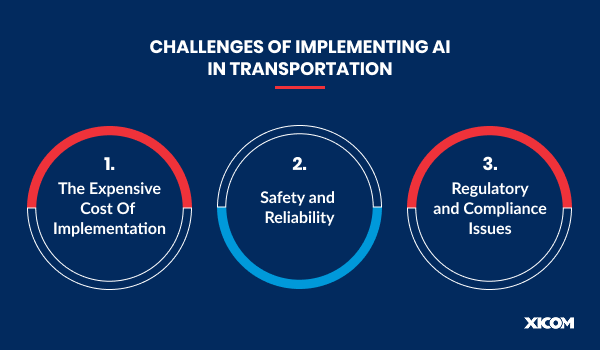
While implementing AI capabilities in transportation always seems easier, practically, even tech brands have encountered some of the major challenges. If you are all set to implement AI in the automobile industry, then here are the possible challenges that you may come across.
To adopt smart capabilities in the transportation sector, you required a significant upfront investment in sensors, software, and hardware. Also, businesses have to hire top mobile app development companies to manage these systems, which ultimately adds to the cost. For smaller companies or startups, these investments can be a highly significant barrier.
Solution to this Problem: The higher initial cost can be easily covered up with the long-term benefits like improved efficiency, reduced fuel consumption, and minimized downtime. To make this concept work out, you can ask your team to plan a phased rollout, starting with pilot projects and scalable solutions, to manage costs effectively and spread financial investments over time.
When it comes to using AI in transportation, even a small error by AI can lead to significant safety risks, particularly in applications like autonomous driving or air traffic control. In addition, it is important to protect sensitive data from breaches, and unauthorized access is crucial in AI-powered transportation systems.
Solution to this Problem: The simplest way to protect it from data breaches or any errors is to implement robust encryption, offer strict access controls and perform regular security audits to safeguard data and maintain privacy.
Another challenge that aligns with using AI in transportation is to meet the regulatory requirements. In the transportation industry, it is difficult for companies to navigate the legal requirements. Regulations are necessary to ensure safety and privacy, but meeting compliance can slow down innovation and compliance.
Solution to the Problem: This is where companies should work closely with regulators and policymakers to stay informed about the changing laws and guidelines. Engaging in pilot programs and adhering to industry standards can help businesses ensure compliance while continuing to innovate.
In a nutshell, with so much effort required to implement artificial intelligence in transportation, you must be wondering what benefits it will drive from these efforts?
Let’s look at the significant benefits of using AI in transportation in transformation and logistics industry…
AI application in transportation has not just made the industry more advanced but also helps ensure more efficient travel where safety is on top priority.
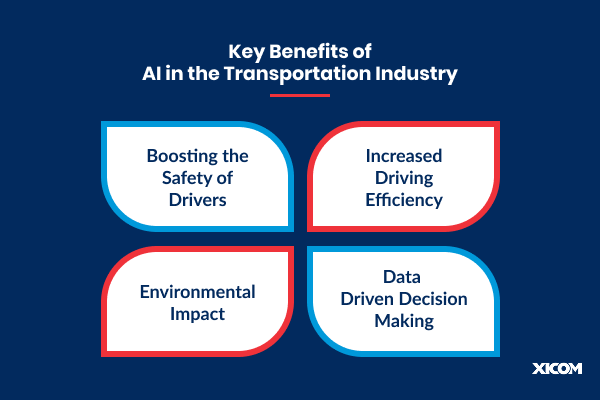
Here’s how AI-powered transportation can be beneficial for you:
Incorporating AI-powered systems in transportation can help detect hazards like lane departures, obstacles, or potential collisions in real-time and ultimately prevent the risk of accidents. As AI advances, self-driving cars may fully reduce the human errors in driving, like fatigue and sleepiness.
Did you know 1500 approx monthly accidents are met because of human errors. A small error can lead to road mishaps. Therefore, implementing AI in improving overall safety on roads and highways across the globe will be a worthy decision.
AI in transportation streamlines traffic flow by using smart systems like intelligent traffic lights and predictive analytics. It helps logistics companies plan optimal delivery routes, reducing fuel consumption and delivery times. This increased efficiency saves time and cost on driving. It ensures a smoother travel experience for commuters and businesses alike.
Using Artificial Intelligence-powered cars helps lower the transportation industry’s environmental footprint. AI-based route planning can minimize the consumption of fuel as it optimizes the routes and can change lanes.
In addition, AI contributes to the advancement of electric and autonomous vehicles, which reduces emissions, supports sustainable travel, and helps governments and businesses meet green energy levels.
The biggest advantage of using AI in the transportation industry is, businesses can extract real-time data from their transportation business. Using the AI-powered systems, it becomes easier to identify congested hotspots, infrastructure issues, and travel trends. This data-driven approach helps cities to plan their traffic effortlessly, conduct road improvements, and make public transit investments.
Are you still managing the transportation operations? If yes, then it’s time to embrace AI capabilities in transportation to automate repetitive tasks and turn them into self-driving cars. That’s not all! Using artificial intelligence in the transportation industry can help you automate repetitive routine tasks, gather and extract the information captured from cameras, sensors, and AI Systems used in the car.
Further, that information has been used for better route planning, avoiding road congestion, and more. However, to embrace this technology in transportation is required you need to hire mobile app development company with AI expertise. The right choice of team can help you transform your idea into reality by understanding your industry-specific challenges.
Here we have gathered additional information related to how Artificial Intelligence is transforming the transportation industry and bringing great change.
Artificial Intelligence is revolutionizing the transportation industry by enabling a wide range of applications. From autonomous vehicles that can drive with minimal human intervention to intelligent traffic systems that manage congestion in real-time, AI is playing a pivotal role.
It’s also used in route optimization, predictive maintenance of vehicles, real-time customer support via chatbots, parking space detection, and even drone-based delivery systems. These innovations are streamlining operations, improving safety, and enhancing the commuter experience.
The AI use in transportation brings numerous benefits, including enhanced road safety, efficient route planning, reduced fuel consumption, and cost savings for both businesses and commuters.
– It helps cities reduce traffic congestion.
– Supports environmental sustainability.
– Empowers logistics companies with better delivery performance.
– AI-driven systems can offer a personalized travel experience
AI is the backbone of autonomous vehicles. AI in self-driving cars allows them to perceive real-time information of their surroundings using sensors and cameras, process complex real-time data, and make driving decisions like turning, braking, or lane changing.
Further, it is being supported by Machine learning algorithms which enable the vehicle to learn from various scenarios and improve driving accuracy over time.
AI also enhances passenger safety by constantly analyzing surrounding conditions and preventing potential accidents, making it a key enabler in the future of mobility.
In this tech driven age, many cities are turning into smart cities by using an AI to improve traffic management by analyzing real-time traffic data collected from GPS devices, surveillance cameras, and sensors embedded in roads.
AI algorithms use this data to optimize the timing of traffic signals, predict congestion hotspots, and reroute traffic accordingly by adjusting the traffic lights in real-time.
This not only reduces waiting times at intersections but also helps emergency services reach their destinations faster. In the long run, AI-powered traffic systems can lead to more organized, efficient, and safer urban transportation networks.
Yes, AI significantly contributes to environmental sustainability in transportation. By optimizing delivery routes and traffic flow, AI reduces fuel consumption and emissions.
Additionally, AI supports the development and operation of electric and hybrid vehicles, which produce fewer greenhouse gases. Smart routing and driving behavior recommendations further encourage eco-friendly practices.
Over time, the integration of AI can play a vital role in achieving net-zero emissions targets in urban mobility systems.
Several industries benefit from AI-driven transportation, including logistics, supply chain, public transit, automotive, aviation, and ride-hailing services.
Logistics companies use AI for delivery optimization and fleet management. Public transportation providers leverage AI for scheduling and passenger load prediction.
Ride-hailing apps use AI to match drivers with passengers efficiently, while the automotive industry uses it for vehicle automation and smart safety features. Even the aviation sector is exploring AI for predictive maintenance and air traffic control enhancements.
AI systems in transportation are designed with safety as a top priority. Advanced algorithms and continuous learning allow these systems to detect hazards faster than human drivers and respond accordingly.
Features like AI-powered collision detection, automatic braking, and lane-departure warnings are already improving road safety. However, like any technology, ongoing testing, regulation, and oversight are necessary to ensure reliability and safety across different environments and use cases.
The future of AI in transportation is incredibly promising. We can expect a greater proliferation of autonomous vehicles, smart cities with real-time traffic control, AI-powered public transportation systems, and drone-based logistics solutions.
AI will play a key role in the shift toward Mobility-as-a-Service (MaaS), where users plan, book, and pay for multiple types of mobility services via a single digital platform. As technology evolves, AI will continue to reshape transportation to be safer, more sustainable, and highly efficient.